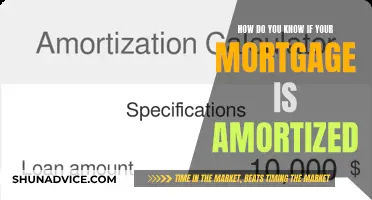
Paying off a mortgage early requires a strategic approach and financial discipline. One of the most effective methods is to make extra payments directly towards the principal. Even small additional payments can cut years off your loan. For example, if you took out a mortgage for $200,000 on a 30-year term at 4.5%, your principal and interest payment would be about $1,000 per month. Paying one extra payment of $1,000 per year would shave 4.5 years off your 30-year term and save you over $28,500 in interest. Another way to pay off your mortgage faster is to refinance to a shorter term. This allows you to lock in a low-interest rate and a shorter loan term. However, the shorter your mortgage term, the higher your monthly mortgage payments will be.
| Characteristics | Values |
|---|---|
| Make extra payments | Making an extra payment each year could reduce the term of your loan significantly. |
| Bi-weekly payments | Paying half your mortgage payment every other week instead of paying the full amount once a month. |
| Lump-sum payments | Applying windfalls such as inheritance or large bonuses to your mortgage's principal balance. |
| Budgeting | Creating a monthly budget to cut back on expenses and free up money for paying off your mortgage early. |
| Trade for a new loan | Opting for a new loan with a lower interest rate or a shorter term. |
| Mortgage recasting | Paying a lump sum toward the principal, resulting in a shorter loan term. |
| Mortgage refinancing | Replacing your current loan with a new one, potentially offering a way to pay off the loan faster. |
| Buy down your rate with points | Prepaid interest paid upfront as closing costs to get a lower rate. |
What You'll Learn

Make bi-weekly payments
Making bi-weekly payments is a strategy that can help you cut your mortgage in half. This strategy involves making half of your monthly mortgage payment every two weeks, instead of making a full payment once a month. By doing this, you will be making 26 half-payments, or the equivalent of 13 full monthly payments, in a year. This adds one extra payment towards your principal balance per year, helping you to save money by reducing the interest charged.
For example, if your monthly payment is $2,000, you can send $1,000 every two weeks. This will result in a faster payoff of your mortgage and significant savings in interest. Over the life of the loan, you will have made four years' worth of extra payments, cutting that time off your mortgage.
Before committing to this strategy, it is important to confirm with your lender or servicer that they allow bi-weekly payments and will apply the extra payments to the principal. Additionally, ensure that there are no prepayment penalties or fees associated with modifying your payment schedule.
Bi-weekly payments can make personal budgeting easier, especially if your income follows a similar schedule. However, if you are on a tight budget, the extra payment per year required for bi-weekly payments may be a strain on your finances. In this case, you may opt for a bimonthly payment plan, where you make half of your mortgage payment on two scheduled days each month, such as the 1st and 15th. While this will result in slightly smaller savings, it may be a more feasible option for those with less financial flexibility.
Requesting a Mortgage Settlement Conference: What You Need to Know
You may want to see also

Refinance to a shorter term
Refinancing to a shorter-term mortgage can be a smart financial decision if you want to lower your monthly payments, shorten the duration of your loan, and build equity faster. However, it is important to consider your financial situation and goals before making this decision.
When you refinance to a shorter-term mortgage, you are replacing your old loan with a new one that has a shorter repayment period. This can be a good option if you want to own your home outright sooner. For example, if you have been paying off a 30-year mortgage for five years and then refinance to a 15-year loan, you will see a significant reduction in the total interest costs. In this scenario, you could save over $143,663 in interest compared to staying with the original 30-year mortgage.
However, it is important to note that refinancing to a shorter-term mortgage will result in higher monthly payments. For instance, in the above example, the monthly payment would increase by about $621. Therefore, it is crucial to ensure that your budget can accommodate this increase. You should also consider any closing costs and fees associated with refinancing, which can range from 2% to 6% of the new loan amount.
Another strategy to pay off your mortgage sooner is to make extra payments towards your principal balance when you can. This could be done by dividing your monthly payment by 12 and adding that amount to your monthly payment, or by making bi-weekly payments, which would result in 13 full payments a year instead of 12. These strategies can help you pay off your mortgage faster without refinancing to a shorter-term loan.
In conclusion, refinancing to a shorter-term mortgage can be a great way to save money on interest and own your home sooner. However, it is important to carefully consider your financial situation and ensure that you can afford the higher monthly payments. There are also alternative strategies to pay off your mortgage faster without refinancing, such as making extra payments towards your principal balance.
Borrowing from Your Mortgage: What You Need to Know
You may want to see also

Make extra payments
Making extra payments is a great way to cut your mortgage in half. This strategy can significantly reduce the term of your loan and the amount of interest you pay. Here are some tips to help you make extra payments and cut your mortgage in half:
- Create a budget and cut back on unnecessary expenses. Track your income, list your expenses, and subtract your expenses from your income to ensure you are not overspending. Look for areas where you can cut back, such as groceries or eating out, and consider shopping sales and in-season produce.
- Make bi-weekly payments. Instead of paying your full monthly amount once a month, pay half of your monthly payment every two weeks. This will result in 13 full monthly payments per year instead of 12, helping you pay off your mortgage faster and save on interest. Be sure to check with your lender or bank to ensure they accept bi-weekly payments.
- Make extra payments towards the principal. When making extra payments, specify that you want the money to be applied to the principal balance, not the following month's payment. This will help you pay down the loan faster and reduce the interest you pay over time.
- Take advantage of windfalls or bonuses. If you receive a year-end bonus, inheritance, or any other unexpected windfall, consider putting this extra money towards your mortgage. This can have a significant impact, especially if done early in the loan term when interest is highest.
- Refinance to a shorter-term loan. Consider refinancing your mortgage to a shorter-term loan, such as a 15-year fixed-rate mortgage with a lower interest rate. While your monthly payments may be higher, you will pay off your mortgage in half the time and save a significant amount in interest.
- Increase your payments gradually. A dollar-a-month strategy can help you pay off your mortgage faster without putting a strain on your budget. Start by increasing your monthly payment by a small amount, such as $1, and then gradually increase it by the same amount each month. Over time, this can help you pay off your mortgage years ahead of schedule.
Remember to check with your mortgage company or lender before making extra payments to understand any prepayment penalties or restrictions they may have. By making extra payments and being strategic with your finances, you can be well on your way to cutting your mortgage in half.
Finding Your Mortgage Balance: What You Need to Know
You may want to see also

Create a monthly budget
Creating a monthly budget is an important step towards achieving your financial goals, such as cutting your mortgage in half. Here's a step-by-step guide to help you create a comprehensive monthly budget:
Calculate Your Monthly Income:
Start by listing all your sources of income. This includes your paycheck from your primary job, as well as any additional income from side hustles, freelance work, or other sources. Calculate your net income, also known as your take-home pay, by deducting taxes, retirement contributions, and insurance premiums from your gross income. If your income varies from month to month, consider using the lowest amount you've earned in recent months as your base income, and you can always adjust later if you earn more.
List Your Expenses:
Create categories and subcategories for your expenses to ensure you capture all your spending. Divide your expenses into fixed and variable costs. Fixed expenses remain consistent each month, such as your rent or mortgage payment, while variable expenses fluctuate, like groceries or transportation costs. Start with essential spending, including food, utilities, shelter, and transportation. Then, list other monthly expenses, such as insurance, debt payments, and childcare. Don't forget to include expenses that may occur annually or less frequently, like property taxes, car insurance, medical or veterinary bills, and vacation costs.
Prioritize Your Expenses:
When budgeting for the month ahead, prioritize certain expenses over others. Consider allocating a percentage of your income to giving or donations. It's also crucial to prioritize saving. Try to set aside a portion of your income for an emergency fund or other savings goals. If you have high-interest debt, focus on paying it off before building substantial savings.
Subtract Expenses from Income:
Subtract your total monthly expenses from your total monthly income. Ideally, your budget should balance, with your income covering all your expenses without dipping into savings or debt. However, if your expenses exceed your income, you may need to make adjustments, such as reducing discretionary spending or finding ways to increase your income.
Track Your Spending:
Throughout the month, diligently track your spending to ensure you're adhering to your budget. You can use budgeting apps that link to your bank account, or you can manually save receipts and record expenses. Tracking your spending helps you identify areas where you may be overspending and allows you to make adjustments for the following month.
Make Adjustments and Stick to Your Budget:
After reviewing your spending history, identify areas where you can cut back. For example, you might reduce dining out or subscription services you rarely use. Look for ways to save on groceries, such as shopping sales or buying in-season produce. Additionally, consider increasing your income by taking on extra work or selling unwanted items. These adjustments will help you stick to your budget and free up more money to put towards your mortgage.
Creating a monthly budget is a powerful tool for understanding and managing your finances. It empowers you to make informed decisions about your money, cut back on unnecessary spending, and prioritize paying off your mortgage faster.
Cosigning a Mortgage: What You Need to Know
You may want to see also

Use mortgage discount points
Discount points are a type of prepaid interest or fee that mortgage borrowers can purchase from mortgage lenders to lower the amount of interest on their subsequent monthly payments. Spending more upfront to pay less later, each discount point generally costs 1% of the total loan amount and lowers the loan's interest rate by one-eighth to one-quarter of a percent.
For example, if your mortgage rate is 5%, one discount point costing 1% of the loan amount would lower your rate to 4.75%. Two points would lower the rate to 4.5%, and so on. By using a discount point calculator, you can estimate how much you could save over the life of your loan if you buy discount points.
The longer the life span of a loan, the more you pay in interest. Therefore, discount points are ideally suited for a fixed-rate, long-term mortgage (20 to 30 years) that will likely not be refinanced anytime soon. Discount points are a good option if you intend to hold a mortgage for a long period.
It's important to note that you should only buy mortgage points if it fits within your budget in the current market conditions. If you can comfortably afford your monthly payments and have money left over for emergencies, discount points could be a worthwhile investment to secure a lower mortgage rate.
Additionally, consider the length of time you plan to stay in your home. Discount points are only effective if you remain in your home long enough to recoup the money spent on them, known as the "break-even" point. This break-even point varies depending on the loan size, interest rate, and term.
Assuming a Mortgage: Dealing with a Deceased's Debt
You may want to see also
Frequently asked questions
There are a few ways to cut your mortgage in half. One way is to refinance your mortgage for a 15-year fixed-rate mortgage with a lower interest rate. You can also make bi-weekly payments, which will allow you to make one extra payment per year. Another way is to make extra payments toward the principal.
You can make extra payments toward the principal by putting extra money toward your mortgage each month. You can also use any unexpected windfalls, such as holiday bonuses, tax returns, and credit card rewards, to make extra payments.
Cutting your mortgage in half will provide you with financial stability and save you money in the long term by accruing less interest. It will also help you build equity in your home faster.







